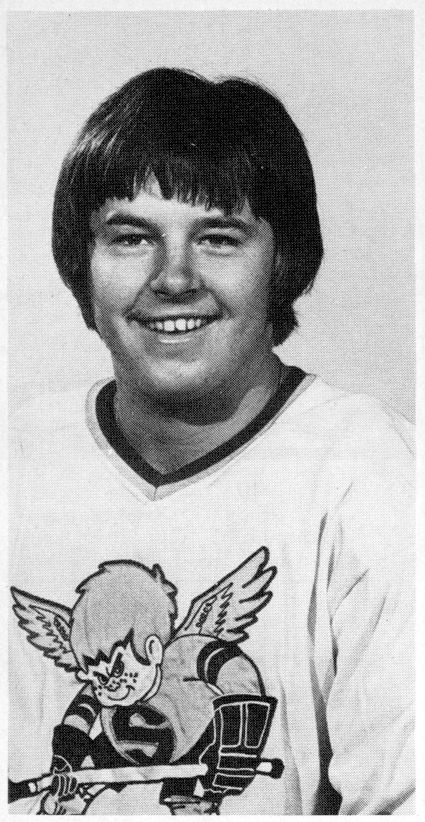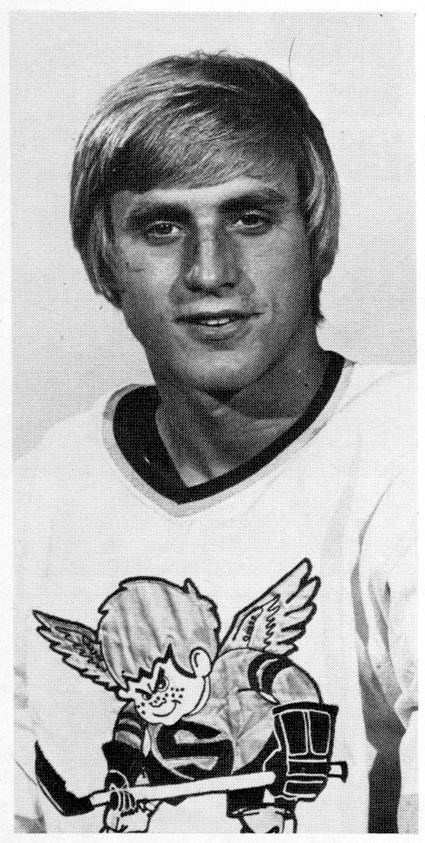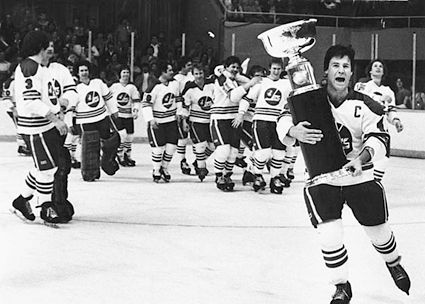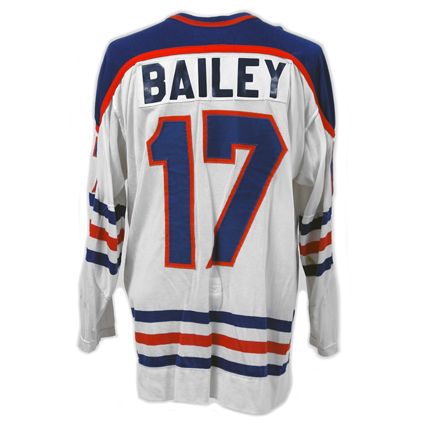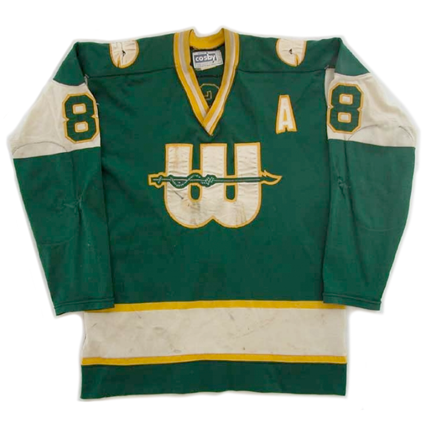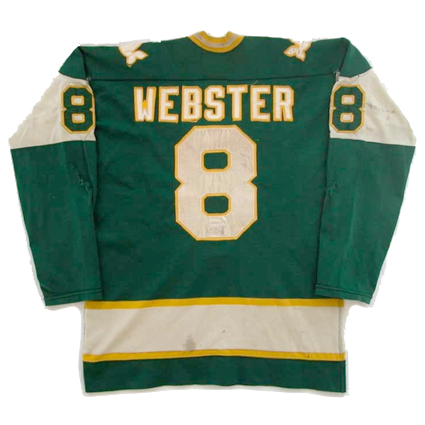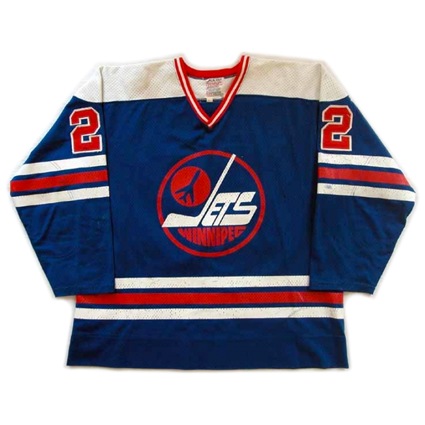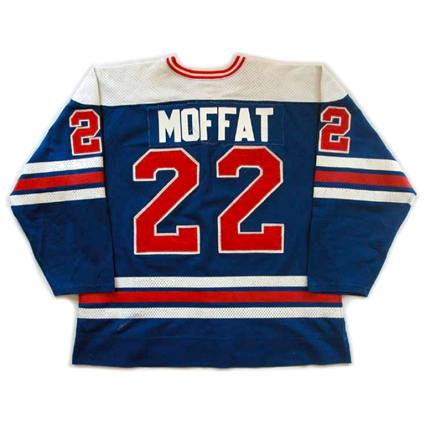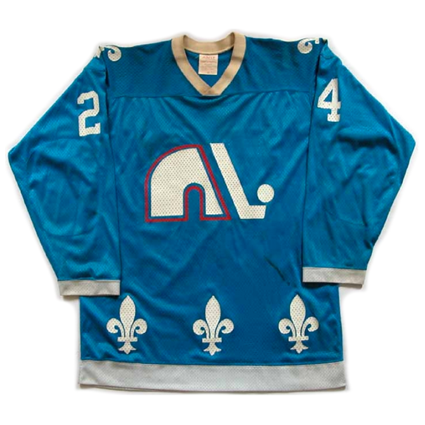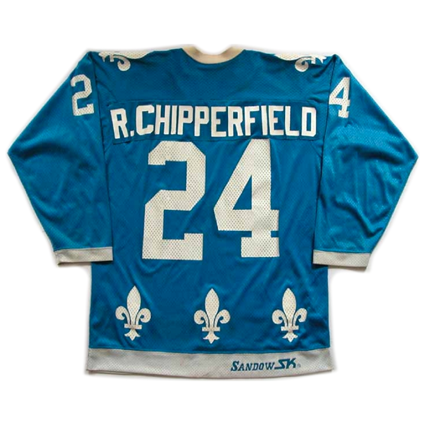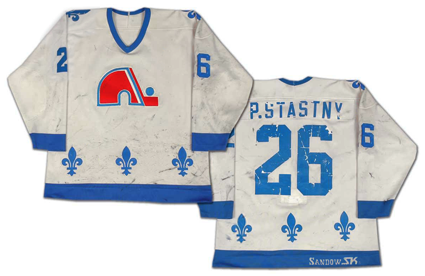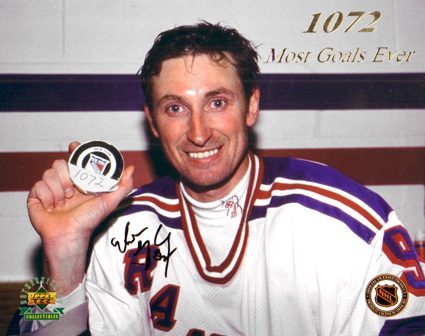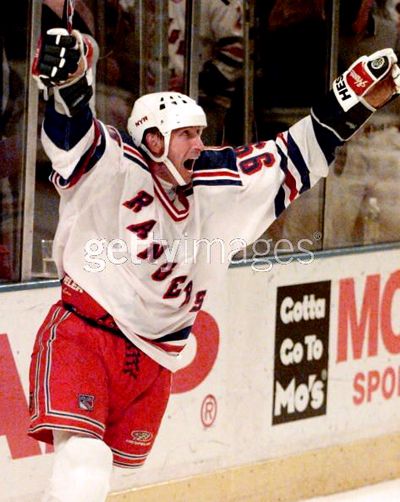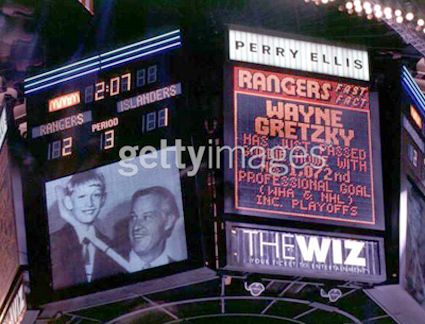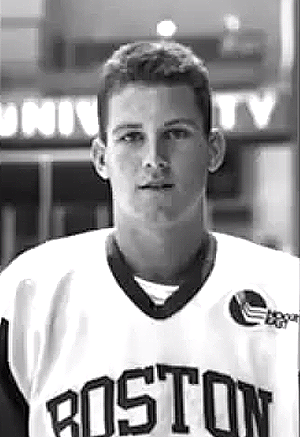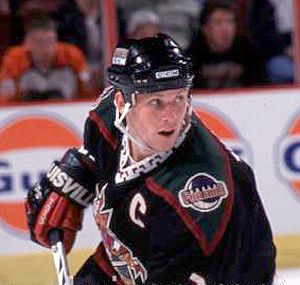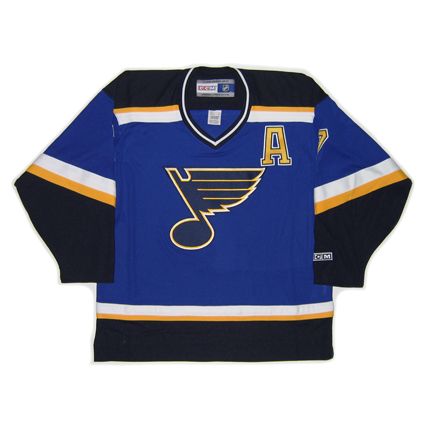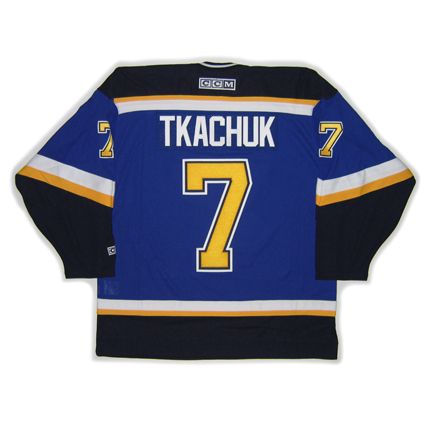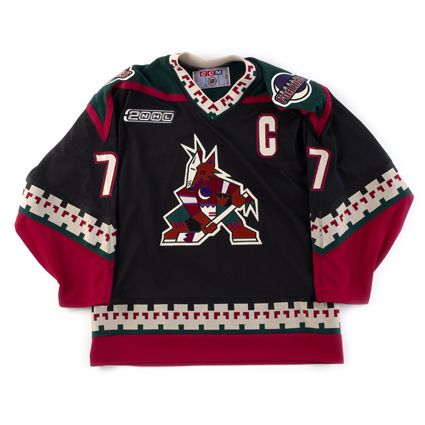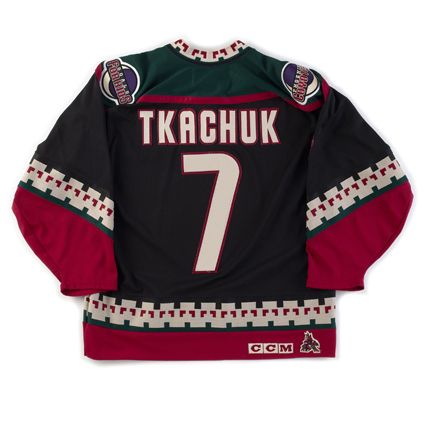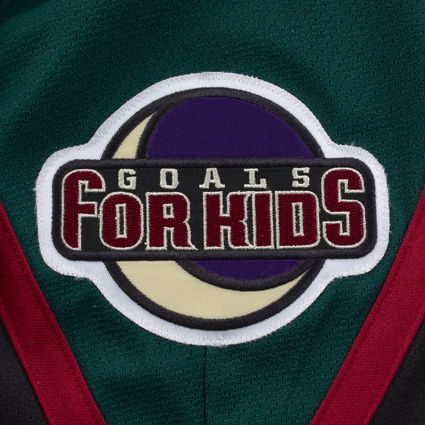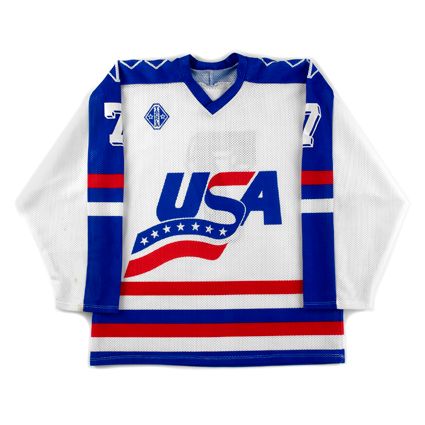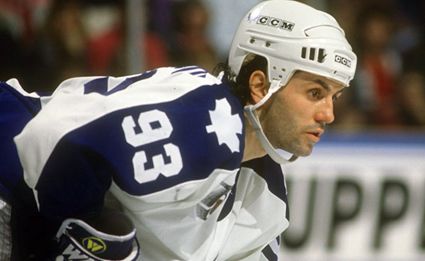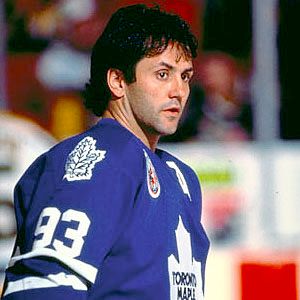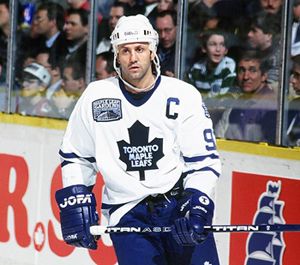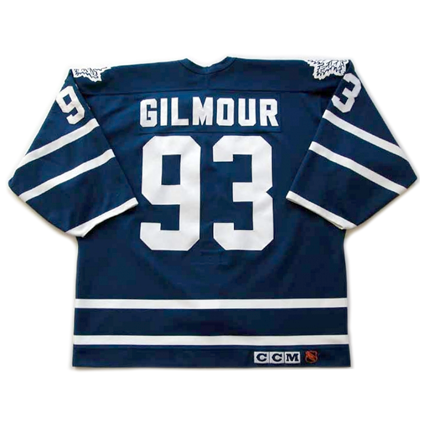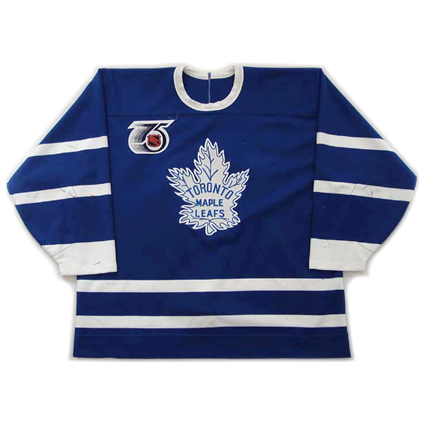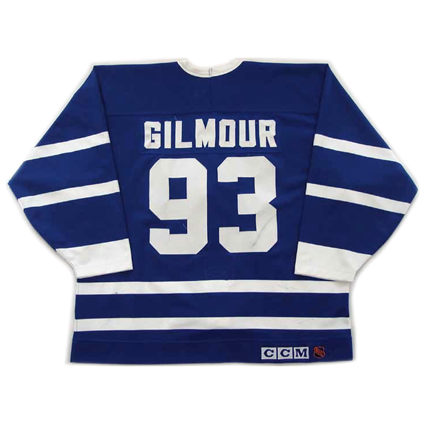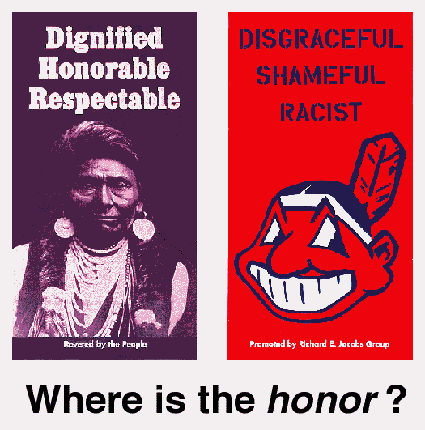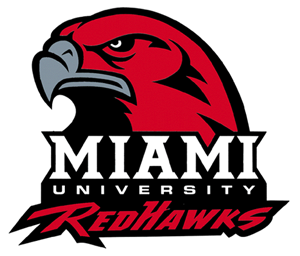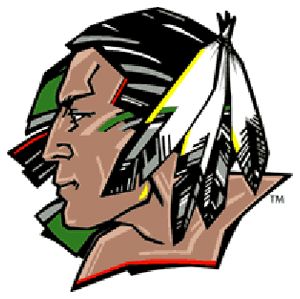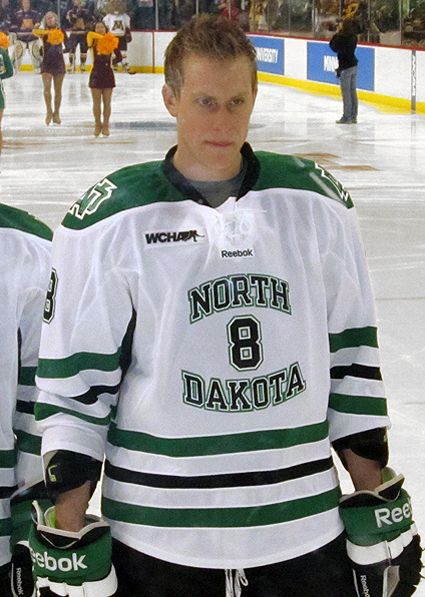Saturday, March 31, 2012
Name Those Pucksters
We here at Third String Goalie have a little quiz for you today. It's quite simple, we are going to post two photos below and simply ask you to identify who these young men are.
Post your answers/guesses in the comments below! We'll post the answers tomorrow. The winner(s) will receive the pride of knowing they are smarter than the average bear.
And now...
Mystery Player #1
Mystery Player #2
Remember, post your answers in the comments section below, and if you don't know, creativity counts!
Labels:
Trivia Contest
Friday, March 30, 2012
1979-80 Quebec Nordiques Ron Chipperfield Jersey
On this date in 1979, the NHL announced the expansion of the league from 17 teams to 21 with the addition of the Edmonton Oilers, Hartford Whalers, Quebec Nordiques and Winnipeg Jets, all of whom played in the World Hockey Association from 1972-73 until 1978-79. Combined, the four clubs won five of the seven Avco World Cup championships, with the defunct Houston Aeros, led by Gordie Howe, having won the other two.
The Jets celebrate winning the final Avco Cup in 1979
When the WHA teams were allowed to enter the NHL, the old WHA teams were permitted to protect only two goaltenders and two skaters, as the NHL teams raided their rosters in the 1979 Expansion Draft, seeking a return of players whose rights they once held.
The WHA teams were also each required to pay a $6 million expansion fee for the privilege of having their team decimated. This was a far different scenario than a "merger" between the leagues, in which case the incoming WHA teams would have been able to keep their rosters intact and not pay an expansion fee.
The Oilers thus stared life in the NHL with a roster consisting of goaltenders Dave Dryden and Eddie Mio, plus skaters Bengt Gustafsson and Wayne Gretzky. Although no NHL team held Gretzky's rights, and under existing rules he would have been removed from the Oilers and placed into the Entry Draft, the Oilers were allowed to keep him with the stipulation of being required to pick dead last in each round of the 1979 NHL Entry Draft of incoming new players, behind even current Stanley Cup champions the Montreal Canadiens.
The WHA teams then selected unprotected players from the current NHL teams to fill out their rosters, but only after the NHL teams were allowed to protect two veteran goalies and seventeen skaters. Think about that for a second. In the best case scenario, a WHA team would get the 20th best player from any NHL team. The results were predictable, as the WHA teams all finished in the bottom eight of the standings. However, a ridiculous 16 of 21 teams made the playoffs back then, so Edmonton and Hartford did manage to qualify for the postseason, with the Oilers being swept in three games by Philadelphia.
Amazingly, within just three years, coach and GM Glen Sather had a team that included Gretzky, but also Mark Messier, Glenn Anderson, Jari Kurri, Paul Coffey, Kevin Lowe plus goaltenders Grant Fuhr and Andy Moog. Easily the most successful to make the transition to the NHL, the Oilers made it to the Stanley Cup Finals for the first time in 1983, losing to the Islanders, before winning the Stanley Cup in 1984, ending the Islanders dynasty and beginning one of their own.
Here is a 1978-79 Edmonton Oilers Garnet "Ace" Bailey jersey from the Oilers final season in the WHA when the home white jerseys had a dreadful combination of blue letters on an orange background while the road blues had orange letters on a white background.
For their first NHL season, the Oilers mercifully changed to a much higher contrast and much more pleasing combination of blue letters against a white background for both their home and road jerseys, which they continue to use to this day.
While Hartford qualified for the playoffs that first NHL season of 1979-80, it would flatter to deceive, as they would miss the playoffs for the next five seasons, including finishing with a league worst 45 points in 1982-83. They would win their only playoff series in 1985-86 with a three game opening round sweep of the Nordiques and follow that with an Adams Division championship thanks to a franchise best 93 points, only to fail in the opening round of the playoffs to Quebec, who finished fourth in the division 21 points behind the Whalers.
Five more consecutive first round exits were followed by five more seasons of failing to qualify for the postseason prior to the franchise relocating to North Carolina, where they would win the Stanley Cup in 2006 as the Hurricanes.
The Whalers not only changed their jerseys for their first NHL season, but were also forced to change their name from the New England Whalers to the Hartford Whalers as the result of a demand by the Boston Bruins, located 102 miles to the northeast.
Here is a WHA-era 1974-75 New England Whalers Tom Webster jersey. Their final WHA jerseys sported a "W" bisected by a harpoon, worn since their second WHA season of 1973-74.
Upon entering the NHL, the Whalers debuted their new "Whale Tail" logo, which obviously featured a "W" for Whalers, but also contained an "H" hidden in the negative space of the logo to represent their change in name to Hartford.
Following their success in the WHA, having won the final two championship titles, the Jets found the transition to the NHL the roughest, as they lost leading scorer Kent Nilsson to the Atlanta Flames, Terry Ruskowski and Rich Preston to the Chicago Black Hawks, Barry Long to the Detroit Red Wings. After having scored 102 points in 1977-78 in the WHA, the Jets plummeted to last in the NHL in 1979-80 with just 51 points. Things got even worse in year 2 with a all-time franchise low of 32 points, which the club turned into first overall selection Dale Hawerchuk.
With the arrival of Hawerchuk, and then Thomas Steen, the club rose to respectability, making the playoffs the next seven seasons, but only winning two playoff rounds over that time. While the club added some remarkable talent in the early 1990's in the shape of Finns Teemu Selanne and Teppo Numminen, Russians Alexi Zhamnov and Nikoali Khabibulin, American Keith Tkachuk, it was not enough to put Winnipeg over the top, as their final eight seasons in Winnipeg saw them miss the playoffs four times and be eliminated immediately the other four prior to their move to Phoenix, Arizona due to economic issues associated with being based in Canada and playing in one of the smallest cities in the league while the Canadian dollar was at a weak point.
This 1977-78 Winnipeg Jets Lyle Moffat jersey illustrates the final style worn in the WHA by the Jets with the white shoulders as well as the lower contrast version of their logo, one with a blue background on a blue jersey, which was immediately changed to a white background for their first season in the NHL for use on their new NHL jerseys, which featured a full length arm stripe from cuff to cuff.
The Jets ushered in their time in the NHL with a completely brand new set of jerseys, adopting a design used by the New York Rangers for a brief period of time when they were under the control of then General Manager John Ferguson, who had taken the same position with the Jets in 1978.
The Jets began life in the WHA with a simple design that featured some unusual contrasting colored and rounded nameplates with an equally odd choice for a font for the names for their first season, but improved their look for 1973-74 by ditching the odd nameplates and font as well as using an improved main crest. This style would remain in use for the rest of their days in the WHA, with the only change being the addition of a white shoulder yoke for the blue jerseys in 1977-78 and 1978-79, as worn while the team captured back-to-back championships to end their days in the WHA.
The Nordiques were unable to qualify for the playoffs during their first NHL season, but quickly became relevant thanks to retaining WHA players Real Cloutier and Marc Tardif and adding in short order Michel Goulet and Peter, Anton and Marian Stastny, who defected from Czechoslovakia at the beginning of the 1980's.
Their intense rivalry with the Montreal Canadiens led to some legendary battles and brawls, particularly in the postseason, as the Nordiques made the playoffs for seven consecutive seasons beginning in 1980-81, including two trips to the conference finals.
After three consecutive seasons of 90+ points, hard times arrived as the team would miss the playoffs six out of seven seasons, including a dreadful period of seasons with 61, 31, 46 and 52 points which allowed the team to select Mats Sundin, Adam Foote, Owen Nolan and Eric Lidros, who was later traded for Peter Forsberg, Mike Ricci, Steve Duchense and Ron Hextall in addition to having already selected future team captain Joe Sakic in 1987.
Unfortunately the same economics of playing in small Canadian city during a low point for the Canadian dollar that plagued Winnipeg also led to the Nordiques relocation, as they were moved to Denver, Colorado, where they would capture their first Stanley Cup in their first season away from Quebec.
Today's featured jersey is a 1979-80 Quebec Nordiques Ron Chipperfield jersey. While the Nordiques were the only one of the four former WHA clubs to keep their same jerseys for their initial NHL season, this was the final season for this variation of the Nordiuqes blue jersey before the Nordiques would change the logo on their road blue jerseys from the white version used in the WHA from 1975-76 to a better looking red version, which matched the one worn on the home whites, leaving the home white Nordiques jersey the only one of the eight possible WHA sweaters to survive the entry into the NHL with any sort of longevity.
Bonus jersey: Today's bonus jersey is a 1980-81 Quebec Nordiques Peter Stastny jersey. The white Nordiques jersey was not only the single jersey to survive the move to the NHL by the four WHA clubs, the Nordqiues were also the final team to use heat sealed numbers on their jerseys before changing over to fully sewn on twill letters and numbers, which they did not adopt until 1991-92, the year they finally added a red outline to their numbers.
This particular jersey shows the wear and tear suffered by the less durable heat sealed material used for the name and numbers on the back. Over time, collectors have had issues with the material peeling off of the jerseys simply due to age, making conservation of these jerseys far more of a challenge than the contemporary jerseys worn by other clubs of the era, which had their names and numbers sewn on.
Today's video in the final minute of the final game in WHA history, as the Jets wrap up their third championship with a win over the Oilers, who would soon win their fare share of championships in the NHL.
Remember the days when fans would come onto the ice after the championship was won? Modern say insurance agents and security personnel all over North America are aghast at the mere thought of it...
Thursday, March 29, 2012
1998-99 New York Rangers Wayne Gretzky Jersey
March 29th has again and again proven to be a significant day in the hockey career of Wayne Gretzky. It begins on this date in 1980, when during his first season in the NHL, Gretzky scored two goals and four assists for a six point night as the Edmonton Oilers beat the Toronto Maple Leafs 8-5.
One year to the day later, Gretzky made NHL history when he broke Phil Esposito's NHL record for Most Points in a Season of 152 when his three assists gave him 153 for the season on his way to setting the bar at 164 points.
Again on March 29th, this time in 1983, Gretkzy posted three assists to break his own NHL record for most assists in a season at 121. He would conclude that season with a new record total of 125.
Two years later, again on the 29th of March, Gretzky would break his own assist record with two assists to raise the mark to 127. His final total for the season and the new record amount would stand at 135.
The final milestone Gretzky would achieve on March 29th would be scoring the final goal of his NHL career. That goal was also his 1,072nd all-time goal, counting the NHL regular season and playoffs plus the WHA regular season and playoffs, which allowed him to surpass Gordie Howe's career total of 1071 all-time goals.
Gretzky poses with his record setting puck
In 6 WHA seasons Howe had 174 regular season goals and 28 playoff goals plus the 801 regular season and 68 playoff goals he scored in his 26 seasons in the NHL for a total of 1071.
Gretzky only played in the WHA for one season, scoring 46 regular season goals and 10 playoff goals. His record setting 894 regular season goals plus his 122 playoff goals, also the all-time record, pushed his career total past Howe by just a single one, the goal he scored on this date in 1999.
Gretzky celebrates his final goal, his 1072nd all-time
In addition to the All-Time Combined Goals record, Gretzky also holds many other goal scoring records including;
Career Records
- Most Career NHL Regular Season Goals - 894
- Most Career NHL Goals Including Playoffs - 1,016
- Most Career NHL Goals by a Center - 894
- Most 40-or-More Goal Seasons - 12
- Most Consecutive 40-or-More Goal Seasons - 12
- Most 50-or-More Goal Seasons - 9
- Most 60-or-More Goal Seasons - 5
- Most Consecutive 60-or-More Goal Seasons - 4
- Most Three-or-More Goal Games - 50
Single Season Records
- Most Goals in a Season - 92
- Most Goals in a Season Including Playoffs - 100
- Most Goals 50 Games From the Start of a Season - 61
- Most Goals by a Center in a Season - 92
- Most Three-or-More Goal Games in a Season - 10
- Highest Goals-Per-Game Average in a Season - 1.18
Single Game Record
- Most Goals in One Period - 4
Career Playoff Records
- Most Playoff Goals - 122
- Most Game-Winning Playoff Goals - 24
- Most Three-or-More Goal Games in Playoffs - 10
Single Season Playoff Record
- Most Shorthanded Goals - one Playoff Year - 3
Single Game Playoff Record
- Most Shorthanded Goals - one Playoff Game - 2
Today's featured jersey is a 1998-99 New York Rangers Wayne Gretzky jersey as worn on the date he broke Howe's all time goal scoring record with his 1,072nd goal, the final goal of his storied career.
The Madison Square Garden scoreboard celebrates Gretzky passing Howe's total
A unique feature of this jersey is the "double-tagging" on the lower back of the jersey. Gretzky had a habit of tucking the right side of his jersey into his breezers, which had the effect of hiding the manufacturer logo customarily located on the back, bottom right of NHL jerseys since the first ones appeared in 1979-80 according to NHLUniforms.com.
Frustrated by having their logos obscured and missing out on the free publicity of being associated with Gretzky, manufacturers started placing their logo also on the left side of jerseys intended for Gretzky's use to ensure their visibility in association with "The Great One."
Today's video is a countdown of the Top 10 Wayne Gretzky moments.
Labels:
Gretzky,
New York Rangers
Wednesday, March 28, 2012
2003-04 St. Louis Blues Keith Tkachuk Jersey
After a year at Boston University, where the Terriers lost a thrilling 8-7 national championship final in three overtimes, as well as beginning his international career by playing for the United States in the 1991 World Junior Tournament, Keith Tkachuk, who was born on this date in 1972, spent the majority of the 1991-92 season playing for the US National Team.
He played a number of games with the national team through December before playing in his second World Junior tournament. Following the World Juniors, Tkachuk then resumed his duties with the US National Team in preparation for the 1992 Olympics in Albertville, France.
After the conclusion of the Olympics, Tkachuk began his NHL career with the Winnipeg Jets, who had drafted him with the 19th pick of the first round of the 1990 NHL Amateur Draft. He got his feet wet with 17 regular season games and seven playoff games prior to embarking on a full NHL season in 1992-93 and joined a Winnipeg team on the rise, which featured an international flavor with Tkachuk joining players from Finland, Russia, Sweden, the United States and Canada. While Tkachuk's 51 points were overshadowed by Teemu Selanne's record shattering 76 goal season, the rugged forward made his presence known in other ways however, as he totaled over 200 penalty minutes, second most on the club.
Tkachuk led the Jets in points the following season with his first 40 goal season (41) and 81 points in 84 games and was named the team captain, a post he would hold for two seasons. Two years later he would raise his game to the next level when he reached the 50 goal mark and again led the Jets in points, this time with 98 in what would be the Jets final season in Winnipeg.
When the Jets relocated to Phoenix, and renamed the Coyotes, Tkachuk made the move with the club and was once again named team captain, the first in Coyotes history. He led the club in scoring once more with 86 points as well as playing in his first NHL All-Star Game. He raised his personal best goal total to 52, which led the NHL and made him the first ever American-born player to do so. He was also only the fourth player in league history to record 50 goals and 200 penalty minutes, making him the definition of the modern power forward.
He repeated as team scoring leader again in 1997-98 and had his fourth season with 40 or more goals with an even 40.
At the trade deadline three seasons later, Tkachuk was dealt to the St. Louis Blues for three players and a first round draft pick following a couple of injury plagued seasons. His impact was immediate as the Blues made it to the conference finals where Tkachuk was second in playoff scoring by a single point with seven goals and ten points in ten games.
Three 30 plus goal seasons followed with Tkachuk leading the Blues in scoring in 2003-04 with 71 points. The Blues traded Tkachuk to the Atlanta Thrashers at the 2007 trade deadline for a player and first, second and third round draft picks only to see Atlanta eliminated in four straight in the first round of the playoffs.
Tkachuk immediately returned to St. Louis as a free agent in time for the 2007-08 season, which included him scoring his 500th career goal on the final day of the season into an empty net. Back for another season with the Blues, Tkachuk scored his 1,000th career point in 2007-08 as part of a 4-2 Blues win over Atlanta, just the sixth American to reach the 1,000 point plateau.
Tkachuk would play one final season with the Blues in 2009-10, finishing his career with 1,021 games played, 538 goals and 527 assists for 1,065 points and 2,219 penalty minutes.
After his initial international experience prior to joining the Jets in 1992, Tkachuk was once more was a member of Team USA at the 1996 World Cup of Hockey, where he earned a gold medal. He returned to the Olympics in 1998 and again in 2002, where he earned a silver medal on home soil. He concluded his international career with one final appearance in the Olympics in 2006 in Torino, Italy. He also made a noteworthy return to the World Cup in 2004, which included a memorable four goal performance against Russia in the quarterfinals.
Today's featured jersey is a 2003-04 St. Louis Blues Keith Tkachuk jersey from the season Tkachuk led the Blues in scoring. The white version of this jersey was introduced as an alternate for the 1997-98 season, and was essentially a modern take on the Blues jerseys worn from 1973 to 1984. Blues fans raved about the new sweaters and they were quickly promoted to replace the controversial multi-diagonally striped previous set which featured a large amount of red, especially on the road jerseys.
With the white alternate now promoted to the new home jersey, a blue version was created as the road jersey, which remained in use for nine years until being retired due to the change to the new Reebok Edge jerseys. We predict if not forced to retire this jersey to make way for the Edge jerseys, the Blues would have continued to use this very clean and striking jersey to this day.
Bonus Jersey: Today's bonus jersey is a 1999-00 Phoenix Coyotes Keith Tkachuk jersey, one of the most unusual primary jerseys in NHL history. It's southwest inspired geometric striping, unusual color palette, it was a very polarizing jersey, as fans either embraced it's unique look or hated how busy the sweater was and called the logo creepy.
A subtle detail of the Coyotes jerseys was the "Goals for Kids" charity patch worn on the left shoulder of the jersey, which from any sort of distance looked identical to the "Phoenix Coyotes" secondary logo on the right shoulder, unlike the separate Goals for Kids patch worn lower on the sleeve of the Winnipeg Jets jerseys prior to the franchise relocating to Phoenix.
Extra Bonus Jersey: Today's extra bonus jersey is a 1992 United States National Team Keith Tkachuk jersey as worn in the 1992 World Junior Tournament held in Germany where Tkachuk scored seven points in seven games as the United States came home with the bronze medal.
Our first video today is Tkachuk scoring his 50th goal of the season into an empty net during the final Winnipeg Jets regular season game in 1996.
Next up is Tkachuk's 500th NHL goal on the last day of the 2007-08 season, also into an empty net.
Here are highlights from Tkachuk's four goal game in the quarterfinals of the 2004 World Cup of Hockey against Russia with his fourth one into an...
empty net.
Finally, a look back at the career of Keith Tkachuk, perhaps the greatest empty net scorer in hockey history!
Labels:
Phoenix Coyotes,
St. Louis Blues,
Tkachuk Keith,
USA
Tuesday, March 27, 2012
1992-93 Toronto Maple Leafs Doug Gilmour Jersey
Doug Gilmour's junior hockey career was spent with the Cornwall Royals, which included winning the 1981 Memorial Cup and leading the OHL in goals (70), assists (107) and points (177) in 1982-83, which included a 55 game point scoring streak which still stands to this day. His 177 point season remains the third highest in league history and earned him the league's Most Outstanding Player award in 1983. Still, concerns over his size caused NHL teams to shy away from him before the St. Louis Blues drafted Gilmour in the seventh round of the 1982 NHL Entry Draft after he was passed over entirely when he was first eligible in 1981.
Originally a defenseman in junior hockey, St. Louis signed Gilmour for the 1983-84 season with the thought he could be a defensive forward. His first three seasons with St. Louis saw Gilmour score in the 50 point range before becoming the first player in league history to lead the NHL in playoff scoring without making the Stanley Cup Finals when he registered 21 points in 19 games in 1986. Having demonstrated his offensive skills, he was give the opportunity to move up to one of the Blues top lines and responded with a career high 42 goals on his way to a 105 point season in 1986-87.
His breakout season earned Gilmour a spot on the Team Canada roster for the 1987 Canada Cup where he scored 2 goals as the Canadians won the championship.
Originally a defenseman in junior hockey, St. Louis signed Gilmour for the 1983-84 season with the thought he could be a defensive forward. His first three seasons with St. Louis saw Gilmour score in the 50 point range before becoming the first player in league history to lead the NHL in playoff scoring without making the Stanley Cup Finals when he registered 21 points in 19 games in 1986. Having demonstrated his offensive skills, he was give the opportunity to move up to one of the Blues top lines and responded with a career high 42 goals on his way to a 105 point season in 1986-87.
His breakout season earned Gilmour a spot on the Team Canada roster for the 1987 Canada Cup where he scored 2 goals as the Canadians won the championship.
The Blues and Gilmour parted ways when he was dealt to the Calgary Flames prior to the 1988-89 season, which proved beneficial for both Gilmour and the Flames, as he was a key contributor to the Flames first and only Stanley Cup championship that season. He finished tied for second with 85 regular season points and his 11 goals and 11 assists in 22 playoff games were good for third on the club.
He would play two and half more seasons in Calgary, including a best of 91 points while with the Flames in 1989-90 before being traded once more, this time to the Toronto Maple Leafs where he was reunited with his former Calgary General Manager Cliff Fletcher in a gigantic 10 player deal. Gilmour was immediately productive in Toronto, scoring 49 points in 40 games.
Gilmour after being traded to Toronto in 1991-92
His second season with the Maple Leafs proved to be the finest of his career. While Gilmour notched 32 goals during the season, his playmaking skills produced assists and a tremendous clip, with the two he recorded on this date in 1993 in a 6-2 win over the Edmonton Oilers allowing him to surpass Darryl Sittler's franchise record of 117 points.
He would continue to pile up the points, eventually pushing the mark up to 127 total points, which still stands as the club record, now 19 years later. Gilmour's 95 assists that season were easily more than double his next closest teammate Glenn Anderson's 43. Following the season Gilmour was named the winner of the Selke Trophy and finished second in voting for the prestigious Hart Trophy. Additionally, he became extremely popular with the fans in Toronto thanks to his all-out, two-way style of play, evidenced by his accumulation of scars nearly as quickly as points.
Gilmour during his record setting second season with the Maple Leafs
During the postseason, Gilmour led the Maple Leafs to the conference finals following Game 7 wins over both the Detroit Red Wings and St. Louis Blues before stretching the Los Angeles Kings to a seventh game as he scored an impressive 35 points in 21 games, second most in the league despite not advancing to the finals.
The following season Gilmour finished the season fourth in the NHL in scoring, with his 111 points only one back of Adam Oates' 112. Gilmour again continued to excel in the postseason with 28 points in 18 games, ten more than any other Maple Leaf, as the again returned to the conference finals after defeating the Chicago Blackhawks in 6 and the San Jose Sharks in 7 before falling to the Vancouver Canucks in 5.
The following NHL season was delayed with labor issues until January of 1995, and in the meantime Gilmour kept himself occupied by playing for Rapperswill-Jona in the Swiss National League A for a nine game stint before joining Wayne Gretzky's all-star hockey tour of Europe and then returning to Canada and taking part in the NHLPA's Four-on-Four Tournament, where his Team Ontario won the championship. With the labor issues finally settled, Gilmour returned to Toronto where he was named as the club's new captain, a rank he would hold for the remainder of his time with the team. With the season finally underway, Gilmour would score 33 points in 44 games.
He returned strong in 1995-96 with a 32 goal season, his fourth and final 30 goal season of his career, on his way to 72 points, good for second on the team.
Gilmour's final season with Toronto came in 1996-97 when he played in 61 games before a trade to the New Jersey Devils, as the Maple Leafs had slipped from their two peak seasons of 99 and 98 points down to a season which would conclude with 68 points, necessitating a rebuilding effort for Toronto, which saw Gilmour dealt for three players in return.
Maple Leafs captain Gilmour during his final season in Toronto
He would then play another season for the Devils, two for the Chicago Blackhawks before a trade to the Buffalo Sabres, with whom he would play one season prior to two seasons with the Montreal Canadiens. During that period of his career, Gilmour's game, along with the style of play in the NHL, would see his point scoring limited to less than 60 per season. At the trade deadline of his second season with Montreal, he was traded back to Toronto, but fate would intervene as a collision during his second shift would result in a torn ACL, causing him to miss the remainder of the season and then announcing his retirement prior to the start of the 2003-04 season.
Gilmour would finish with 1,474 games played during which he scored 450 goals and 964 assists for 1,414 points.
The Maple Leafs would honor Gilmour's #93 on January 31, 2009 and he would be inducted into the Hockey Hall of Fame in 2011.
Today's featured jersey is a 1992-93 Toronto Maple Leafs Doug Gilmour jersey as worn during the game in which he broke the Maple Leafs single season scoring record. Following the well received Turn Back the Clock jersey worn by Toronto for select games during the previous season in honor of the NHL's 75th Anniversary, the Maple Leafs debuted a brand new jersey for the 1992-93 season, which featured a much more simple and classic style.
The twin white stripes on the arms and waist were first used by Toronto in 1934-35 and remained in use all the way through 1966-67. That basic jersey was paired with the Maple Leafs current, modern logo as well as the Turn Back the Clock jersey's retro style leaf logo as the new secondary shoulder logo. Despite changes in the fonts for the names and numbers for a period and the transition to the new Reebok Edge jerseys in 2007-08, this jersey has remained in use for as long as Gilmour's scoring record has stood.
Bonus jersey: Today's bonus jersey is a 1991-92 Toronto Maple Leafs Turn Back the Clock Doug Gilmour jersey. This is the jersey which inspired the changes in the Maple Leafs jersey for 1992-93, ditching the previous style, which had frankly run it's course, in favor of the retro inspired new jersey.
Today's video segment begins with the first part of the jersey honoring ceremony for Gilmour by the Maple Leafs.
No one is a bigger fan of "Dougie" Gilmour than Don Cherry, and not just because they both hail from Kingston, Ontario. How many times do you think that he would be suspended for those hits in today's NHL?
Labels:
Gilmour Doug,
Toronto Maple Leafs
Monday, March 26, 2012
2011-12 North Dakota Fighting Sioux Dan Senkbeil Jersey
By now you have probably all heard about the ongoing dilemma the University of North Dakota finds itself in regarding the use of their long time nickname, the "Fighting Sioux".
North Dakota was once known as the "Flickertails", but officially became "The Sioux" back in 1930, with the descriptor "Fighting" being added during the 1960's.
In the 1960's, protests began against the use of Native American names and imagery, focused on such teams as the Cleveland Indians and Atlanta Braves of Major League Baseball and Kansas City Chiefs and Washington Redskins of the NFL getting the most publicity. While some consider the names to be a tribute to the most positive and desirable traits of native peoples, others say the names, and particularly some of the imagery, such as logos and mascots, are demeaning in their perpetuation of negative stereotypes.
It's a devisive issue however, as a poll by Sports Illustrated concluded although most Native American activists and tribal leaders consider Indian team names and mascots offensive, neither Native Americans in general nor a cross section of U. S. sports fans agree, stating "There is a near total disconnect between Indian activists and the Native American population on this issue."
The protests against major league teams has resulted in the most publicity, but little to no changes. The impact on high school and college names has been a different story though. In 2005 the NCAA required schools to discontinue their use of names they deemed "hostile and abusive", but certain schools had already begun voluntarily changing their names.
Some schools have taken steps to gain approval for their names from local tribes in order to continue their use of Native American names, with the Florida State Seminoles being the most cited example, while Marquette, Miami of Ohio, UMass Lowell, Quinnipiac and St. John's all took the route of changing to new names.
Meanwhile, North Dakota has attempted to take the route of gaining local approval and maintaining the use of "Fighting Sioux", with the Spirit Lake Sioux tribe agreeing, but the Standing Rock Sioux tribe withholding their approval. Without the needed approval by the October 1, 2009 deadline, various motions have been passed to phase out the use of the name by the end of the 2010-11 sports season, only to be superseded by the North Dakota Senate passing legislation ordering the school to retain the use of it's nickname!
Additionally, a petition has been completed that would put the issue to a statewide vote, all of which sees the University still using the name "Fighting Sioux". However... the NCAA has not changed it's stance on the issue, and sent a letter to the University on March 1, 2012 restating it's current policies concerning the school's participation in NCAA championships and stating that the school risks losing the right to host any postseason games if their athletes cheerleaders or even their band display the name "Fighting Sioux" or their American Indian head logo, which was designed by Bennett Brien, an American Indian artist who holds a Master of Fine Arts degree from UND.
Brien describes his logo with the following statement.
"The feathers symbolize the outstanding rewards that students, faculty, staff and alumni will achieve for academic, athletic and lifelong excellence. The determined look in the eyes symbolizes fortitude and never giving up and the focus necessary for sustained academic, athletics and lifelong achievement. The paint on the cheekbone symbolizes that life can be a battle and we have daily struggles. The color green symbolizes the development of young people and their growth at the University of North Dakota. The color yellow symbolizes the sun which provides humanity, light and warmth in order that life may continue. The color red symbolizes the lifeblood that has been poured out to make our state and peoples great."
The logo debuted in 2001-02 to coincide with the opening of the brand new, state-of-the-art Ralph Engelstad Arena, paid for by Engelstad, the "Fighitng Sioux" name's most public and ardent supporter, who incorporated literally thousands of examples of the Indian head logo into the new facility and threatened to halt construction of the arena the moment the school dropped his beloved "Fighting Sioux" nickname.
It's our contention that if any attempt were ever made to remove the logo embedded into the floor of the arena's lobby, Engelstad's passion for the name would have demanded that the building be designed to implode into itself!
The NCAA then reaffirmed it's stance on March 1, 2012, in anticipation of both the men's and women's teams being named to their respective national tournaments, that any UND teams participating in postseason games using the logo would risk forfeiture of the game and the NCAA reserves the right to seek reimbursement for expenses incurred, all of which leads us up to this past weekend, as the University of North Dakota Fighting Sioux men were named the #1 seed in the West Regional of the 2012 Division I Men's Ice Hockey Championship in St. Paul, Minnesota.
North Dakota's first game came on Saturday against the Western Michigan Broncos, and for the occasion, UND wore new jerseys, as illustrated by today's featured jersey, a 2011-12 University of North Dakota Fighting Sioux Dan Senkbeil jersey. The new uniforms feature the name "North Dakota" arched around each players number. Additionally, the green shoulder yoke contains a ND monogram, but no signs of Brien's banned "Sioux head" logo to be found, prompting the fans of the rival Minnesota Golden Gophers to chant "Where's your lo-go? Where's your lo-go?" on one occasion during their 5-2 win over the North Dakota, um..., uh..., North Dakotas? Flickertails? No Namers? Suhakis? (a cheeky effort to name the team after an endangered Russian antelope, which just happens to be pronounced "Sioux Hockey"!)
While the NCAA may have the authority to tell the school what their players, cheerleaders and band can wear, the public is still free to choose to wear what they please, and the fans of the Fighting Sioux travel very well to events like the NCAA playoffs. This past weekend was no exception, as they showed by the thousands in St. Paul wearing many, many different styles of jerseys from the history of the Fighting Sioux hockey program, which dates back to 1932.
Here is a slideshow of the photos we took of the fans in attendance, wearing as many varieties as we could document over the course of two days.
Get your Fighting Sioux jersey while you still can!
For a complete look at the history of the jerseys worn by the University of North Dakota Fighting Sioux, we highly recommend the excellent Sioux-Jersey.com.
Today's video segment begins with the end of the National Anthem from a Fighting Sioux game.
Next up, supporters of the Fighting Sioux name turn in their petitions to support a public vote to keep the name.
Here is a video which documents the ongoing battle over the name Fighting Sioux. This video was posted to youtube in December of 2010 before several subsequent events in the controversy, as mentioned above, including the state senate mandating use of the name after the school had made final plans to discontinue it's use.
Labels:
University of North Dakota
Sunday, March 25, 2012
Jack Jablonkski KFAN Interview
Today were are thrilled to present a segment from the KFAN Power Trip morning show withe their surprise guest hockey expert, Jack Jablonski, the high school player paralyzed earlier this season after being checked from behind.
Jack discusses the recent Minnesota State High School Hockey Tournament won by his team, the Benilde-St. Margaret's Red Knights, who led by Grant Besse's record setting five goal performance, three of which were shorthanded and three of which were unassisted.
He then gives his opinions on the upcoming NCAA college hockey West Regional, which will see yesterday's winners facing off today at 4:30 PM Central time today.
They then discuss his thoughts on fighting in the NHL and gives a medical update on his progress. He's really a remarkably upbeat and resilient young man. It was something we really felt was worth sharing and runs 3:20. Just click the arrow below to listen.
Jack still faces a lot of rehabilitation and therapy in the days ahead, so please consider clicking on the link below to donate to the Jack Jablonski Fund.
Labels:
Jablonski
Introducing The New Mobile Version of Third String Goalie!
Friday we launched a new mobile version of Third String Goalie, which we feel looks much better and adds some nice interactive functionality, which you will hopefully find useful, including:
- Mobile versions of our latest stories
- Viewing our latest Twitter posts
- A "share" feature which will allow you to send us immediate feedback via Twitter with the "@" and "#" tags pre-loaded for your convenience
- A link to our Facebook page
- A small gallery featuring the Worst Jerseys of All-Time
- A gallery of videos
- An about us page
That's a fair amount more than just reading our latest stories, which was all our previous version offered, and we're pretty excited about it.
Also for your convenience, here is a scannable QR code to give the new mobile version a quick test drive.
We are fully aware that not every "update" on the internet is an "improvement" (see this week's Facebook change to their new "timeline" as a prime example), so we welcome your feedback on the new look, which was brought to you buy SquareShare.
If you have a web site and would like a great looking mobile version, you can't believe how quick and easy it is to create one using their simple interface. It's got our highest endorsement and you'll love price - free!
Subscribe to:
Comments (Atom)

